Abstract
Prosopis species forests in Argentina are increasingly fragmented in the last years mainly by the deforestation activity without any reforestation strategy, the establishment of different crop plantations, and natural fires. The consequence of habitat fragmentation on the genetic potential of Prosopis alba requires a fine-scale analysis of population structure, in particular mating system and pollen dispersal. By means of short sequences repeats, we analyzed a fragmented population of this species in Santiago del Estero (Argentina). Most genetic variation was observed among families within zones (65.5%), whereas the lowest proportion corresponded to the differentiation among zones (2.8%). The fine analysis of structure at family level suggests that this population is complete outcrosser and there is a low but significant biparental inbreeding. Outcrossing rates differ among mother plants and the proportion of full sibs within mother plants ranged from 64% for seeds proceeding from the same pod to 10% for seeds from different pods. The average pollen dispersal distance was estimated to be among 5.36 and 30.92 m by using the KinDist or TwoGener approach. About seven pollen donors are siring each progeny array and the number of seed trees necessary for seed collection aiming to retain an effective population size of 100 was estimated in 16–39 individuals depending on the relatedness estimator used. Pollen and seed dispersal would be limited, what determines the need of conserving short distant patches to avoid the effects of inbreeding and drift within populations as a consequence of intensive use resource for agriculture.


Similar content being viewed by others
References
Agapow PM, Burt A (2001) Indices of multilocus linkage disequilibrium. Mol Ecol Notes 1:101–102
Aguilar R, Quesada M, Ashworth L, Yvonne Herrerias D, Lobo J (2008) Genetic consequences of hábitat fragmentation in plant populations: susceptible signals in plant traits and methodological approaches. Mol Ecol 17:5177–5188
Austerlitz F, Smouse PE (2001) Two-generation analysis of pollen flow across a landscape. II. Relation between FFT, pollen dispersal and interfemale distance. Genetics 157:851–857
Austerlitz F, Smouse PE (2002) Two-generation analysis of pollen flow across a landscape. IV. Estimating the dispersal parameter. Genetics 161:355–363
Bessega C, Ferreyra L, Julio N, Montoya S, Saidman BO, Vilardi JC (2000) Mating system parameters in species of genus Prosopis (Leguminosae). Hereditas 132(1):19–27
Bessega C, Saidman B, Darquier MR, Ewens M, Sánchez L, Rozenberg P, Vilardi JC (2009) Consistency between marker- and genealogy-based heritability estimates in an experimental stand of Prosopis alba (Leguminosae). Am J Botany 96:458–465
Brown JR, Archer S (1987) Woody plants seed dispersal and gap formation in North America subtropical savanna woodland: the role of domestic herbivores. Vegetatio 73:73–80
Burkart A (1976) A monograph of the genus Prosopis (Leguminosae subfam. Mimosoidae). Journal Arnold Arboretum 57:219–249
Cascante A, Quesada M, Lobo JJ, Fuchs EA (2002) Effects of dry forest fragmentation on the reproductive success and genetic structure of the tree Samanea saman. Conservation Biology 16:137–147
Cockerham CC (1969) Variance of gene frequencies. Evolution 23:72–84
Crow JF, Kimura M (1970) An introduction to populations genetics theory. Harper and Row, London
R Development Core Team (2011) R: a language and environment for statistical computing. R Foundation for Statistical Computing: Vienna, Austria. ISBN 3-900051-07-0. Available from: http://www.R-project.org
Dick CW, Hardy OJ, Jones FA, Petit RJ (2008) Spatial scales of pollen and seed-mediated gene flow in tropical rainforest trees. Tropical Plant Biol 1:20–33
Eckert CG, Samis KE, Lougheed SC (2008) Genetic variation across species geographical ranges: the central marginal hypothesis and beyond. Mol Ecol 17:1170–1188
FAO (2007) Situación de los Bosques del Mundo, Roma, Italia. http://www.fao.org/docrep/009/a0773s/a0773s00.htm
Fernández OA, Busso CA (1997) Arid and semi-arid rangelands: two thirds of Argentina. RALA Report: 200.
Ferreyra LI, Bessega C, Vilardi JC, Saidman BO (2004) First report on RAPDS patterns able to differentiate some Argentinean species of Section Algarobia (Prosopis, Leguminosae). Genetica 121(1):33–42
Ferreyra LI, Bessega C, Vilardi JC, Saidman BO (2007) Consistency of population genetics parameters estimated from isozyme and RAPDs dataset in species of genus Prosopis (Leguminosae, Mimosoideae). Genetica 131:217–230
Ferreyra LI, Vilardi JC, Tosto D, Julio N, Saidman BO (2010) Adaptive genetic diversity and population structure of the “algarrobo” [Prosopis chilensis (Molina) Stuntz] analysed by RAPD and isozyme markers. Eur J Forest Res 129:1011–1025. doi:10.1007/s10342-010-0386-z
Fuchs EJ, Hamrick JL (2011) Mating system and pollen flow between remnant populations of the endargered tropical tree, Guaiacum sanctum (Zygophyllaceae). Conserv Genet 12:175–185
Genisse J, Palacios RA, HOC PS, Carrizo R, Moffat L, Mom MP, Agullo MA, Picca (1990) Observaciones sobre la biologia floral de Prosopis (Leguminosae, Mimosoidae). I1 Fases florales y visitantes en el distrito Chaquefio Serrano. Danviniana 30:71–85
Goudet J (2005) Hierfstat, a package for R to compute and test hierarchical F statistics. Mol Ecol Notes 5: 184–186. http://www.unil.ch/popgen/softwares/hierfstat.htm.
Goudet J, Raymond M, DeMeeus T, Rousset F (1995) Testing differentiation in diploid populations. Genetics 144:1933–1940
Hafez ESE (1962) The behavior of domestic animals. Williams and Wilkins, Baltimore, MD
Hamrick JL (1994) Genetic diversity and conservation in tropical forest. In: Drysdale RM, JS Yapa A (eds) Proceedings on International Symposium on Genetic Conservation and Prosuction of Tropical Forest Tree Seed. Asia–Canada Forest Tree Seed Centre, Muack-Lek, Saraubi, Thailand. pp 1–9.
Hamrick JL (2004) Response of forest tree to global environmental changes. Forrest Ecol and Manag 197:323–335
Hardy O, Vekemans X (2002) SPAGeDI: a versatile computer program to analyze spatial genetic structure at the individual or population levels. Mol Ecol Notes 2:618–620
Jump AS, Penuelas J (2006) Genetic effects of chronic habitat fragmentation in a wind-pollinated tree. Proc Natl Acad Sci USA 103:8096–8100
Keys RN (1993) Mating systems and pollination biology of velvet mesquite (Prosopis velutina Wooten). Thesis dissertation. University of Arizona
Keys RN, Smith S (1994) Mating system parameters and population genetic structure in pioneer populations of Prosopis velutina (Leguminosae). Am J Bot 81:1013–1020
Kramer AT, Ison JL, Ashley MV, Howe HF (2008) The paradox of forest fragmentation genetics. Conserv Biol 22:878–885
Lander TA, Boshier DH, Harris SA (2010) Fragmented but not isolated: contribution of single trees, small patches and long-distance pollen flow to genetic connectivity for Gomortega keule, an endangered Chilean tree. Biol Conserv 143(11):2583–2590. doi:10.1016/j.biocon.2010.06.028
Levin DA, Kerster HW (1974) Gene flow in seed plants. Evol Biol 7:139–220
Loiselle BA, Sork VL, Nason J, Graham C (1995) Spatial genetic structure of a tropical understory shrub, Psychotoria officinalis (Rubiaceae). Am J Bot 82:1430–1425
Lowe AJ, Boshier D, Ward M, Bacles CFE, Navarro C (2005) Genetic resource impacts of habitat loss and degradation; reconciling empirical evidence and predicts theory for neotropical trees. Heredity 95:255–273
Lynch M, Walsh B (1998) Genetics and analyses of quantitative traits. Sinauer, Sunderland, MA
Mantel N (1967) The detection of disease clustering and a generalized regression approach. Cancer Res 27:209–220
Mares MA, Enders FA, Kingsolver JM, Neff JL, Simpson BB (1977). In: Simpson BB (ed) Mesquite: its biology in two desert ecosystems, US/IBP synthesis Series. Hutchinson and Ross: Stroudsburg 7: 124–149
Mottura MC, Finkeldey R, Verga AR, Gailing O (2005) Development and characterization of microsatellite markers for Prosopis chilensis and Prosopis flexuosa and cross-species amplification. Mol Ecol Notes 5:487–489
Peakall R, Smouse PE (2006) GENALEX 6: genetic analysis in Excel. Population genetic software for teaching and research. Mol Ecol Notes 6:288–295
Pometti CL, Pizzo B, Brunetti M, Macchioni N, Ewens M, Saidman BO (2009) Argentinean native wood species: physical and mechanical characterization of some Prosopis species and Acacia aroma (Leguminosae; Mimosoideae). Bioresour Technol 100(6):1999–2004
Pometti CL, Palanti S, Pizzo B, Charpentier JP, Boizot N, ResioC SBO (2010) Durability of five native Argentine wood species of the genera Prosopis and Acacia decayed by rot fungi and its relationship with extractive content. Biodegradation 21(5):753–760
Queller DC, Goodnight KF (1989) Estimating relatedness using genetic markers. Evolution 43:258–275
Reynolds HG (1954) Some interrelations of the Merriam kangaroo rat to velvet mesquite. J Range Manag 7:176–180
Ritland K (1989) Correlated matings in the partial selfer Mimulus guttatus. Evolution 43:848–859
Ritland K (1990) A series of FORTRAN computer programs for estimating plant mating systems. J Hered 81:235–237
Ritland K (1996) Estimators for pairwise relatedness and individual inbreeding coefficients. Genet Res 67:175–185
Ritland K (2002) Extensions of models for the estimation of mating systems using n independent loci. Heredity 88:221–228
Ritland K, Jain SK (1981) A model for the estimation of outcrossing rate and gene frequencies using n independent loci. Heredity 47:35–52
Robledo-Arnuncio JJ, Austerlitz F, Smouse PE (2006) A new indirect method of estimating the pollen dispersal curve, independently of effective density. Genetics 173:1033–1045
Robledo-Arnuncio JJ, Austerlitz F, Smouse PE (2007) POLDISP: a software package for indirect estimation of contemporary pollen dispersal. Mol Ecol Notes 7:763–766
Roig FA (1993) Aportes a la Etnobotánica del Genero Prosopis. In: Contribuciones Mendocinas a la quinta Reuni6n Regional para América Latina y el Caribe de la Red de Forestación del CIID. Unidades de Botánica y Fisiología vegetal IADIZA. pp 99–121
Saidman BO, Vilardi JC (1993) Genetic variability and germplasm conservation in the genus Prosopis. In: Puri S (ed) Nursery technology of forest tree species of arid and semiarid regions. Winrock–Oxford and IBH, New Delhi, pp 187–198
Sebben AM (2006) Sistema de reproduccion en species arboreas tropicales e suas implicancacoes para la selecao de arvores matrized para reforestamentos ambientais. In: Higa AR, Silva LD (eds) Pomares de sementes en especies forestais nativas. FUPEF, Curitiba, Brasil, pp 93–138
Secretaría de Ambiente y Desarrollo Sustentable de la Nación (2004) Dirección de Bosques. Unidad de Manejo del Sistema de Evaluación Forestal, Informe sobre deforestación en Argentina
Smouse P, Dyer RJ, Westfall RD, Sork VL (2001) Two-generation analysis of pollen flow across a landscape. I. Male gamete heterogeneity among females. Evolution 55:260–271
Sork VL, Smouse PE (2006) Genetic analysis of landscape connectivity in tree populations. Landscape Ecol 21:821–836
Squillace AE (1974) Average genetic correlations among offspring from open-pollinated forest trees. Silvae Genetica 23:149–156
Verdes P (2007) Micropropagación de Prosopis caldenia BURK.: estado actual y perspectives. Revista Científica Agropecuaria 11(1):45–51
Wood SN (2001) mgcv: GAMs and generalized ridge regression for R. R News 1(2):20–25
Young A, Boyle T, Brown T (1996) The population genetic consequences of habitat fragmentation for plants. Trends Ecol Evol 11:413–418
Acknowledgments
This research was supported by funding from Consejo Nacional de Investigaciones Científicas y Técnicas (CONICET) PIP 11220090100147 and Universidad de Buenos Aires (EX 201 and 20020100100008) given to JCV and BOS. A special thanks to the Lic. Ariel Guionet from the Servicio de Secuenciación y Genotipificado from Departamento de Ecología Genética y Evolución, FCEyN, UBA.
Ethical standards
In order to fulfill the objectives proposed, the experiments conducted comply with the current Argentine laws and all the trials were made without disturbing the natural ecosystem taking into consideration the current legislation in the country. For the experimental laboratory practice, done at Facultad de Ciencias Exactas y Naturales (Universidad de Buenos Aires), we followed the recommendations from Servicio de Higiene y Seguridad (SHyS, FCEyN, UBA).
Conflict of interest
The authors declare that they have no conflict of interests.
Author information
Authors and Affiliations
Corresponding author
Additional information
Communicated by P. Ingvarsson
Rights and permissions
About this article
Cite this article
Bessega, C., Pometti, C.L., Ewens, M. et al. Strategies for conservation for disturbed Prosopis alba (Leguminosae, Mimosoidae) forests based on mating system and pollen dispersal parameters. Tree Genetics & Genomes 8, 277–288 (2012). https://doi.org/10.1007/s11295-011-0439-6
Received:
Revised:
Accepted:
Published:
Issue Date:
DOI: https://doi.org/10.1007/s11295-011-0439-6




